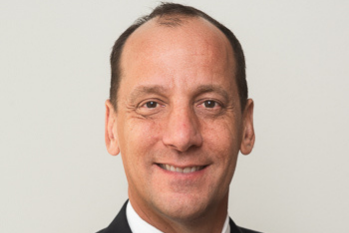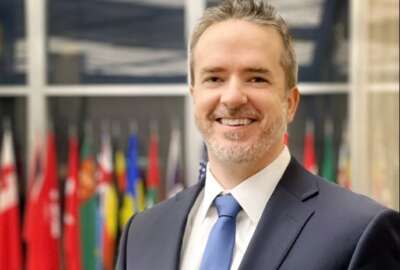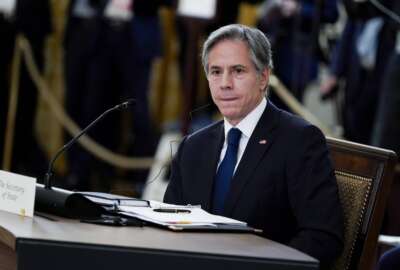USAID wants to make it easier for partners to compete for its grant money
The U.S. Agency for International Development has launched a set of online resources to help new partners get together with experienced ones and with the agency.
Best listening experience is on Chrome, Firefox or Safari. Subscribe to Federal Drive’s daily audio interviews on Apple Podcasts or PodcastOne.
The U.S. Agency for International Development is looking to expand the roster of organizations it partners with around the world. So it’s launched a set of online resources to help new partners get together with experienced ones and with the agency. It’s all housed at a new site called Work With USAID. With details, USAID’s Industry Liaison Matthew Johnson joined Federal Drive with Tom Temin.
Interview transcript:
Tom Temin: Mr. Johnson, good to have you on.
Matthew Johnson: Thanks, Tom. Good to be here.
Tom Temin: And maybe just quickly review for us what partners do and how they relate to USAID. Basically, the work you do overseas is done through local partners, correct?
Matthew Johnson: That’s correct. So the US Agency for International Development, or USAID for short, is a government agency that supports US foreign policy by improving the lives and well being of people around the world. We are funded by the American people, the American taxpayer dollars that support our budget. And each country we work in, we have different goals and interventions that we are planning to undertake. We then look for organizations to partner with us to help implement what we call projects or activities around the world. Each year we partner with around 3,000 organizations in more than 100 countries on behalf of the American people. And like you mentioned, we partner with local organizations, but we also partner with US small businesses, the private sector, faith based communities, universities, as well as non-governmental organizations. And we do that through working through grants, contracts and cooperative agreements, which all of them can be found on SAM.gov and grants.gov, like most other federal agencies.
Tom Temin: Alright. And let’s talk about this latest gambit here, a new site, workwithUSAID.org. What are you trying to accomplish here?
Matthew Johnson: So really for us at USAID, advancing diversity, equity, inclusion and accessibility is sort of at the heart of our work, both with whom we partner and how we partner. We know that organizations around the world can play a role in addressing some of the global challenges, so we’re continually looking to expand who we partner with. So to that end, we wanted to create a platform that allows us to more intentionally and sustainably connect with groups around the world. So the new workwithUSAID.org is a free resource hub for both prospective and current partners that allows them to connect with one another, as well as learn how to partner with us. It’s also a critical resource for USAID staff having people around the world, it’s often a difficult time trying to identify who are some of the capable partners that are out there doing work. So we have on the website something called a partner directory that allows organizations to create a profile, sort of identify themselves and others in the community, letting folks know who they are. We also have a really helpful pre-engagement assessment that allows organizations to self evaluate their readiness to actually be able to compete with USAID funding. We have a library of resources, a news and insights blog and a frequently asked questions that really helps guide organizations on the pathway to partnership with USAID.
Tom Temin: Now, when you have partners in foreign countries doing the work locally, and you use diversity and inclusion, how does that apply overseas where the whole setup in the whole demographic situation is completely different than it might be in the United States?
Matthew Johnson: So I think for USAID we want our programs and activities to reflect not only the American people, but the people in the communities that we’re working in. So with our partnerships, we’re looking for partners that both reflects the diversity of the United States, as well as the diversity of the communities that we are in. There’s a lot of diversity in a lot of the countries that we work in as well. And so we want to make sure that we’re accurately capturing those organizations and working with those groups to promote their development in the countries that we’re working in.
Tom Temin: And do you know which country is the biggest recipient of USAID work? Just out of curiosity.
Matthew Johnson: Yeah, so it changes from year to year which countries are the biggest recipients of work. USAID has been very active in places like Afghanistan or Iraq throughout the years, just historically have been some of our larger programs.
Tom Temin: Got it. So you’re reaching out to other and trying to get a more diverse and newer crop, I guess, of partners, both here and overseas. What’s the incentive for existing partners to give those people advice and help, because it could take away from their ability to work with USAID?
Matthew Johnson: Yeah that’s a great question. I think sometimes a common misperception, a lot of our traditional partners, organizations that we’ve been working with for a long time, are actually connecting with local partners working with others as subcontractors, subawardees on their work. So we actually do have a vast number of sort of sub-partners that are working with us. And so for our traditional partners or organizations that are used to working with us having this directory and being able to register really allows them to be able to identify other capable organizations that they can partner with. If we’re going into a new country or new program in Kenya on education, an existing partner that’s been working with USAID can research what are some of the other capable education organizations that are based in Kenya that they could potentially partner with. So it actually really helps them to strengthen their proposals to USAID and help them to promote better development in their work because they’re being able to partner with organizations globally around the world.
Tom Temin: We’re speaking with Matt Johnson, he’s industry liaison and communications director for the Office of Acquisition and Assistance at the US Agency for International Development. And this is the opportunity for partners, either here or again overseas, to subcontractors, subgrant with primary partners. Does that relationship exist?
Matthew Johnson: Yeah, that exists. And I think that’s one of the key elements that we’re trying to set up with this new platform. For many of the organizations that are new to USAID, one of the first questions they asked, who are some of USAID’s existing partners who can we partner with. We know that it’s a challenge sometimes partnering with any US government organization just because of the regulations and requirements that exist in getting federal funding. And actually working with a sub-partner to USAID program or project is one of the best pathways into working with USAID. So creating this partner directory allows us to help connect our long standing traditional partners with newer partners to be able to better partner and work together.
Tom Temin: And are the partners mostly grantees or mostly contractors, or is it so evenly divided?
Matthew Johnson: It’s about a third of our program are contractors, about a third of our program are grantees and about a third use what we call cooperative agreements, which are sort of a mixture between grants and contracts. It’s a pretty evenly split across the three different large mechanisms that we use.
Tom Temin: And getting back to this new site, this new set of resources, it sounds like in many ways it’s almost acting as a directory for newcomers to be able to find out who they can work with.
Matthew Johnson: Yeah, that’s certainly one of the key elements of it. But really, one of the best things about the website is something we call a pre-engagement assessment that allows organizations to identify what is their readiness in being able to work with USAID. As we look at trying to work with new partners, there’s often a gap between sort of what USAID is trying to do and what an organization, what their sort of internal capacity is. So with this pre-engagement assessment, we’ve set up a very simple 48 question assessment that organizations can look at their programs, their budget and finance, sort of their human resource structure and setup, that really allow them to kind of determine what is their readiness to be able to work with USAID. We curated all of the resources that kind of exist out there, how to work in international development, and created this kind of curated library of tools and information. So actually, after an organization takes this pre-engagement assessment, they’re directed to resources and information that actually helps them build their own capacity to be able to work with USAID. Since we launched the website, we have over 800 organizations already registered in the partner directory, and people are beginning to take this partner, this pre engagement assessment. So it really is a place for folks to connect with one another, but then also a place for organizations really to determine what is their even potential to be able to work with USAID and then really to build their own capacity to be in a better position to compete for funding.
Tom Temin: I was going to say the effect of this is not only that you find new partners, but also that you in some sense build up the local capabilities of partners in those countries to work with USAID or anybody else they can work with.
Matthew Johnson: Exactly. That’s one of the critical goal of what USAID is trying to do is build up the capacity of local organizations. And having these tools and resources allow us to really help build a cadre of capable organizations in all the countries that we’re working in.
Tom Temin: Because infrastructure, energy, environment, education are areas that USAID works in. And so I imagine say, this is probably a crude example, but if a construction company knows how to build out of mud and whatever, but USAID wants to build out of bricks and cinder blocks for permanence and safety, then that local company could move up a notch in its abilities to build things.
Matthew Johnson: Exactly, exactly. I think what we’re always looking to do, how can we strengthen the communities and countries that we’re working in to get to a point where foreign assistance or the work that USAID is no longer needed in the country that we’re working in, building the capacity of local organizations is critical to that.
Tom Temin: Matthew Johnson is industry liaison and communications director for the Office of Acquisition and Assistance at the US Agency for International Development. Thanks so much for joining me.
Matthew Johnson: Thanks, Tom. Appreciate it.
Copyright © 2025 Federal News Network. All rights reserved. This website is not intended for users located within the European Economic Area.
Tom Temin is host of the Federal Drive and has been providing insight on federal technology and management issues for more than 30 years.
Follow @tteminWFED






